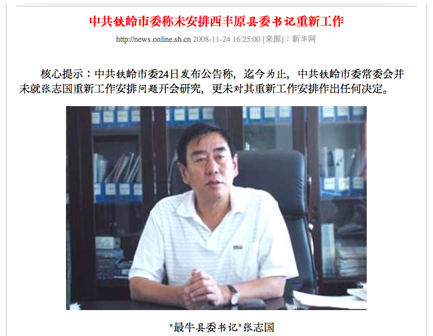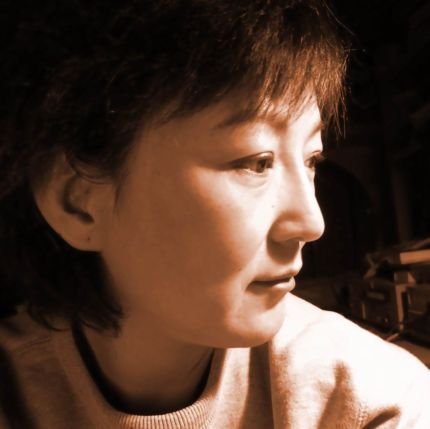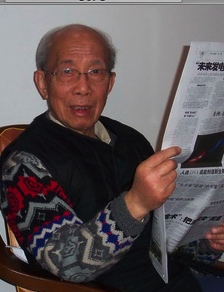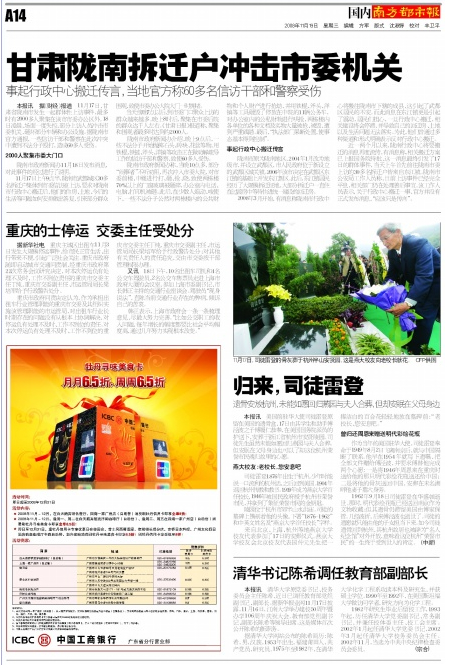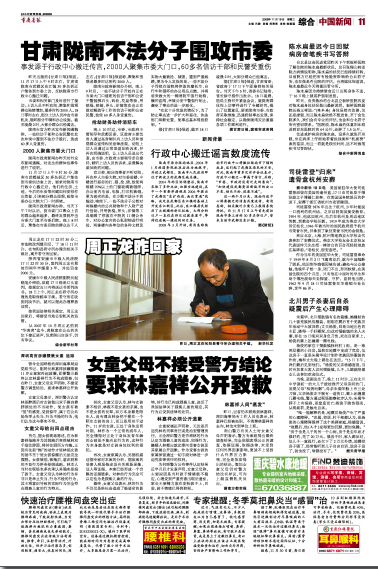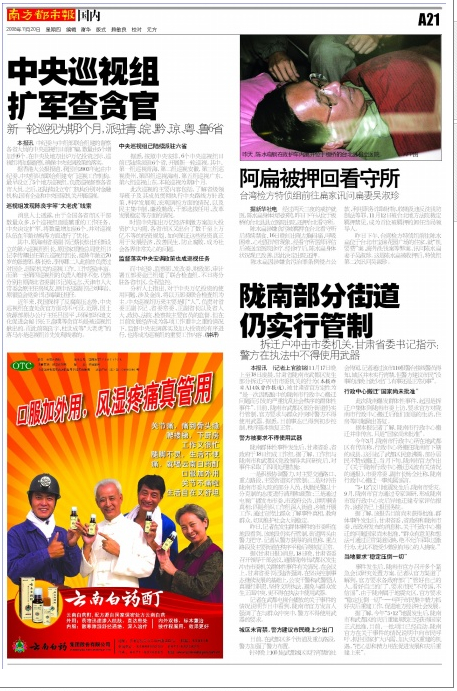By David Bandurski — At first glance, Control 2.0 seems to herald a more open-handed approach to news and information in China, promising rapid coverage of sudden-breaking news events. But it has worked with growing effectiveness this year as an open hand that deals a back-handed slap to the news, and that sends international media spinning into orbit. [Frontpage image by cbcastro available at Flickr under Creative Commons license.]
What we consume from Xinhua News Agency and the usual suspects (People’s Daily, local party newspapers, etc.) in the immediate aftermath of sudden-breaking news events, or tufa shijian (突发事件), is pretty much the best we can expect in China. And the same goes for international coverage.
The basic point you can glean from coverage so far of the Longnan riots, whatever the source, is that we are all, thanks to the party’s more active approach to shaping news coverage, consuming and transmitting the same “authoritative” CCP facts.
We are tops spinning in place.
When news of the incident in Longnan broke on Tuesday, it was from three official sources:
1. An article in the official Gansu Daily
2. An official Xinhua News Agency release [English version here]
3. An official statement from the news office of the Longnan City People’s Government
Here are all three of these sources as they appeared online Tuesday afternoon.
The Gansu Daily version was actually on the front page of the print newspaper, what one might under other circumstances have seen as a welcome sign of change.
In the past, what we’ve generally seen are embarrassing local stories pushed to the back or avoided altogether in local party dailies, while coverage comes predominately from commercial newspapers in other cities or provinces.
If you insist on seeing the glass as half full, you can cite this as one of your reasons for optimism.
Anyhow, the Gansu Daily story read:
“Mass Petition Incident Occurs in Longnan City’s Wudu District”
Gansu Daily reporting. At approximately 9am on November 17, more than 30 residents facing eviction and relocation in Dongjiang Township, Wudu District, Longnan City, gathered at the office of the party committee to voice [their views] on the problem of the relocation of Longnan’s administrative center.
The party committee and relevant departments quickly received their petitions. As the petitioners would not be satisfied, the mass of onlookers continued to grow, reaching as many as 2,000 people. In the early hours of November 18, a number of petitioners attacked the offices of the party committee and other government offices, causing damage to vehicles and other office facilities. By 2am [on the 18th] most of the masses gathered had already left.
After receiving a report [on the incident], the provincial party committee and provincial government had given the case a high level of priority. At 5pm on November 17, Party Secretary Lu Hao (陆浩) and Governor Xu Shousheng (徐守盛) issued their instructions. In the early hours of November 18, Lu Hao called an urgent meeting to carry out special research on the Longnan Mass Petitioning Incident (陇南群体性上访事件), seeking opinion on disposal [of the crisis] and demanding that the Longnan Party Committee and the city government take measures to quickly bring the situation under control, ensuring social stability and securing the smooth resumption of post-quake reconstruction efforts.
While Gansu Daily‘s version of the story led meager print coverage of the story on November 18, including in the Legal Mirror and Shenzhen Evening News, the Xinhua News Agency version dominated coverage on the Internet, where we saw reports from:
*Phoenix Online [CHINESE]
*Reuters news agency [CHINESE] (adding material from the Longnan city government statement)
*UPI [ENGLISH]
*CNN Website [ENGLISH] (Xinhua version + a few Chinese chatroom comments)
*AFP [ENGLISH]
Like the CNN website, the AFP version frosted what was basically a Xinhua report with a brief reference to Chinese internet posts and a couple of paragraphs of background:
The official state media did not offer further details on the dispute, but government-backed land grabs, often in collusion with developers, have become one of China’s most sensitive social issues . . .
Gansu neighbours Sichuan province, which was at the epicentre of the May 12 earthquake that left up to 88,000 people dead or missing.
It is no surprise, of course, to see international newswires relying largely on Xinhua for these initial news reports. Even if they do have the resources to dispatch reporters to the scene, this takes time.
In a report late Wednesday, the strongest foreign wire report of the day, the AFP reached three additional sources by phone, including a party employee, a hotel receptionist and an unnamed local policeman. Reuters coverage on Wednesday supplemented official facts with quotes from a “hotel worker” and from a foreign risk analyst in Beijing (not related to Longnan).
None of the foreign wire reports available differed substantially from the official story.
The most notable coverage of the Longnan story on Tuesday came from Caijing Online, the now fairly autonomous online edition of the leading current affairs magazine Caijing.
Caijing led with a map infographic of Longnan from the original Gansu Daily report, and supplemented facts from Gansu Daily and the Longnan government statement with background material on the recent history of urban development in Longnan, probably drawn from prior news coverage and other material in the public domain:
After the re-drawing of [city] districts in 2004, Longnan City used many means to intensify local development. One important measure was a strategy (“东扩西进、南北贯通”战略) for Wudu District, which involved a decision to develop the Dongjiang New District on the foundation of Wudu District’s Dongjiang Township (东江镇). After this, residents in Dongjiang Township were faced with a wide-scale land requisition campaign, and the majority of residents have lived ever since in transitional demolition and relocation quarters waiting to move into resettlement homes.
Beginning in March 2008, there was news that the city’s administrative center would be moved . . . and this made the residents of Wudu District uneasy. They were concerned that once they had lost the advantages of an administrative center, the overall development of Wudu would be impacted. The news that the administrative center would be relocated created an even bigger stir in Dongjiang Township, where residents worried that relocating the administrative center would mean related developments would cease, including preparation for their resettlement homes, and that the issues of land and subsistence would not be resolved for them. With these concerns, they went through many different means and channels to voice their opposition to the relocation of the administrative center.
On this matter, the Longnan city government on a number of occasions held meetings to say that the removal of the administrative center was a rumor, that “the party committee and the government have no intention of relocating” and that their “determination to build a bright new city in Wudu had not changed …”
Caijing‘s own augmentation of the official version of events actually influenced coverage at two newspapers the next day [See top of list below]. Here’s a taste of where coverage was being sourced at the fifty-odd party and commercial newspapers that ran the story on Wednesday.
Chongqing Morning Post (Sources material from Caijing Online and Gansu Daily)
Southern Metropolis Daily (Sources material from Caijing Online and Gansu Daily)
Shenzhen News (Sources material from Xinhua News Agency via People’s Daily Online)
The Beijing News (Sources material from Gansu Daily and “other sources,” basically Xinhua)
Changsha Evening News (Sources material from Xinhua but rewrites lead to focus on “a few people with ulterior motives”)
Jinan Daily (Uses shortened version of the Xinhua report)
Beijing Times (Uses Gansu Daily version)
[ABOVE: Page A14 of Wednesday’s Southern Metropolis Daily runs state media coverage of riots in Longnan plus some Caijing Online material.]
[ABOVE: Page 11 of Wednesday’s Chongqing Evening Post with coverage of the Longnan riots from the official Gansu Daily.]
The two papers using some Caijing Online material were a rare but notable exception to what was otherwise exclusively official information. All other reports were sourced from Xinhua News Agency, Gansu Daily and the Longnan government’s official statement.
A smattering of editorials on the Internet reflected on the Longnan incident, some pointing the finger at the local government.
The AFP noted one People’s Daily Online editorial in its Wednesday report, with the misleading suggestion that this was “an unusual move apparently aimed at placating the protesters.” It was not. And reporters are warned against assuming material at People’s Daily Online have even an iota of the gravitas of articles appearing in People’s Daily, the official party mouthpiece.
The most strongly worded editorial, in fact, came from CN Hubei, and was available by late Tuesday night:
Water is a soft and yielding substance, but stir it up and it surges with unimaginable power. That is why the ancients said: “As water can float a vessel, so can it capsize it.” Ordinary people are the water, and the government is the boat, and if the vessel and the water cannot exist in harmony then the result is difficult to predict, and ghastly to contemplate. We have as our best examples a number of dynasties with strong soldiers and sturdy horses that were overthrown by ordinary people. We have some officials who don’t understand this most elementary of principles, who treat the ordinary people as weak and amenable water. This is bound to raise the ire of the masses, creating conflict, destroying the goodwill between the party and the masses, between cadres and the masses, and impacting the development of harmony and the economy. Should these profound lessons not alarm us and cause us to reflect more deeply?
Gansu Daily reported on November 18: at November 17 at around 9am, more than 30 residents facing demolition and removal [from their residences] gathered to petition in Dongjiang Township (东江镇) of Wudu District (武都区) in Longnan City (陇南市), expressing [their opposition] regarding the relocation of Longnan’s administrative center (行政中心). The office of the party secretary and relevant government offices moved quickly to hear their petitions, but those petitioning were not to be discouraged and the crowd of onlookers continued to grow, reaching as many as 2,000 people. In the early morning hours of November 18, a number of petitioners assaulted the administrative building of the local party committee, damaging a number of vehicles and some office equipment. The area had already been mostly deserted by 2am.
Our Great Leader Mao Zedong once said: “In this world there is no such thing as love without reason, nor hate without reason.” Most ordinary Chinese are the kind of people who see lightning and fear that their ears will be shaken, who fear for their heads when leaves drop from the trees . . . Sometimes, all it takes is a fart from an official to send them running for the hills. This time around, when they’ve actually eaten bear heart and panther gall, daring to attack the office of the party secretary and destroy vehicles, exchanging their cotton trousers for leather ones — there must be a reason. Dogs leap the wall when they’re desperate, and rabbits gnash their teeth. These ordinary people once had houses to live in, but after demolition and removal [of these properties], the compensation they have received doesn’t enable them to buy homes. Tell me, how could they not petition?
Chinese news coverage today (Thursday, November 20) is again dominated by Xinhua News Agency and Gansu Daily. Thirty print news articles and three editorials are returned in our database of 300+ mainland newspapers with a search on “Longnan” and “incident” (陇南 and 事件).
Here are some examples:
Information Times (Xinhua release)
Shijiazhuang Daily (Xinhua release)
Sichuan Legal Daily (Xinhua release)
Tianjin Daily (Xinhua release)
Xin’an Evening News (Xinhua release)
Hainan Daily (Xinhua release)
Legal Daily (Bylines a compilation of official news sources, mostly from Gansu provincial level)
Shanghai Morning Post (Xinhua release)
Chongqing Morning Post (Xinhua, China News Service and China National Radio)
Harbin Daily (Xinhua release)
Spring City Evening Post (Xinhua and China News Service)
The Beijing News (Xinhua and other official sources)
Wuhan Evening Post (Xinhua release)
Official coverage is obviously everywhere today. But lest readers of English feel left out of the party message, here is the Xinhua version for international consumption from China Daily:
Police departments must standardize procedures for law enforcement and build harmonious relations with the people, the country’s top public security official said on Tuesday.
Speaking at a teleconference with local police heads, State Councilor and Minister of Public Security Meng Jianzhu said police should “be fully aware of the challenge brought by the global financial crisis and try their best to maintain social stability” . . .
Meng’s comments come in the wake of a clash between protestors and police in Longnan, Gansu province.
On Monday, thousands of people, angered by a property dispute, stormed the city’s Party headquarters, smashing windows, burning cars, and injuring more than 60 government workers and police, a statement from the local government said yesterday.
The situation is now “under control”, it said.
The Xinhua News Agency reported yesterday that the protesters have left the site and order has been restored . . .
Or, if you prefer the Gansu Daily version, you can read a mouthful about how order has been restored, how leaders are doing their utmost, and how everything is just, well, hunky-dory — except for those nasty petitioners “with ulterior motives”:
Things returned to normal on November 19 after a mass incident in which the office of the party committee was attacked. During the reporter’s interviews today, cadres and the masses all expressed their desire for stability and harmonious development, and their earnest hope for the quick rebuilding of their homes damaged during the earthquake [in May].
At 9am on November 19, most shops along the streets of Wudu District had opened their doors for business. People came and went on the street outside the gate to the offices of the Longnan Party Committee . . . [See Southern Metropolis Daily eyewitness refutation of this last statment below.]
One cadre said: “Our Longnan has just recently suffered seriously from the earthquake disaster, and it is one of the areas affected most seriously. After the earthquake happened, the party and the government cared very much about the disaster area, and everyone in the throughout the nation and the province did their utmost to support the area, providing the Longnan disaster area with materials and financial support. Now the rebuilding plan for the Longnan District has already been set down, and work has begun already for many projects. The work of rebuilding in the disaster area is going forward urgently, and during a time like this it is very bad to have such an incident as this [riot] occur. This not only affects the normal operation of society, but also affects the work of rebuilding after the disaster. The masses in the disaster area do not approve of such behavior . . .
[ABOVE: Screenshot of Gansu Daily November 20 coverage of Longnan via China.com]
Another key component of Xinhua coverage today is the news that Gansu Party Secretary Lu Hao (陆浩) said during a November 18 meeting with top provincial leaders that officials needed to “reflect back deeply” (深刻反思) on the Longnan incident to ensure a “harmonious and stable environment for economic and social development.”
Gansu Party Secretary Lu Hao said to cadres from various offices of the party and government that [all] needed to reflect back deeply on this mass incident, earnestly seeking its lessons . . . using effective measures to quickly handle social contradictions of various kinds and to create a harmonious and stable environment for economic and social development.
We can only assume on the basis of coverage at present that Lu Hao’s call for “reflection,” or fansi (反思), was not read as an invitation to more independent-minded non-party newspapers to look more deeply into the Longnan incident.
But is there really no news coverage that wanders away from the sanitized state version?
We find the one lone Chinese example in print today in the only place it would probably occur to most China watchers to look for it: Southern Metropolis Daily.
Most of the key facts in the Southern Metropolis Daily report are taken from official sources, including Xinhua and Gansu Daily. But the reporter is apparently on the scene, and the news report is sprinkled with direct observation, including an account that directly contradicts the Gansu Daily report that has people “coming and going” outside the party committee headquarters:
Yesterday, this reporter visited the site at the offices of the party committee where the incident occured and saw that the area was already under lockdown, with police positioned at both ends of the street. According to information this reporter obtained from the police, things will return to normal once order has been restored to key stretches of road and arterial roads . . .
. . . In a television report explaining the [Longnan] incident on the local Wudu TV this reporter saw a spokesperson for the city government of Longnan emphasizing that police had been order not to use weapons in conficts with the masses . . .
. . . Hearing rumors from the public that the city would be under curfew beginning at 10pm, this reporter learned from a dispatcher at the 110 emergency service number that a curfew was not in effect for the city. However [the dispatch said], the police have advised city residents “to go out seldomly at night if they have no business, and to do things as normal if they have business.”
We’ll have to keep an eye out over the next few days to see if Southern Metropolis Daily‘s reporter on the ground — or anyone else — digs up anything interesting.
So far, though, it seems that Control 2.0 is working quite effectively. And that rings true whether you’re reading Harbin Daily or the Las Vegas Sun.
FURTHER READING:
“China at last tries to report the news first,” Reuters, November 20, 2008 [A “writ” from propaganda authorities? Sure, this was it.]
[Posted by David Bandurski, November 20, 2008, 4:32pm HK]
